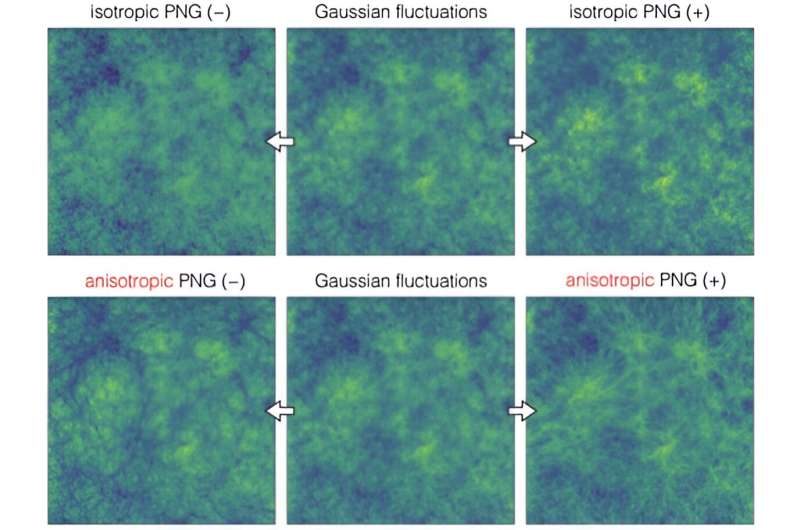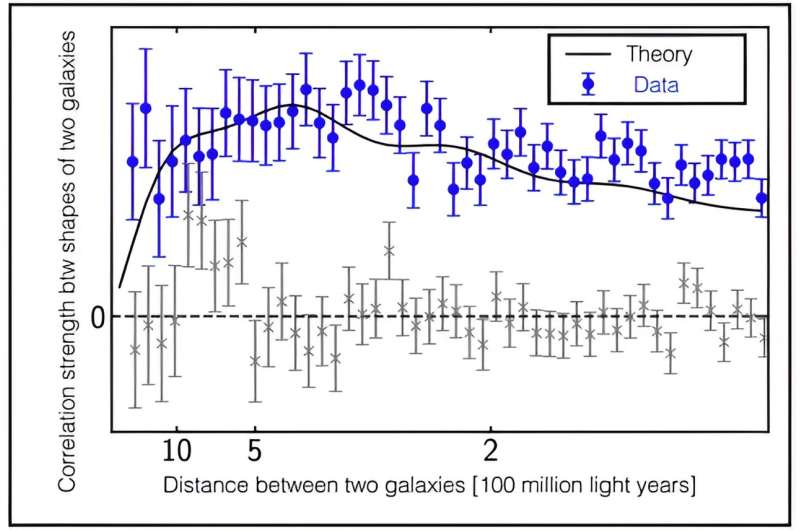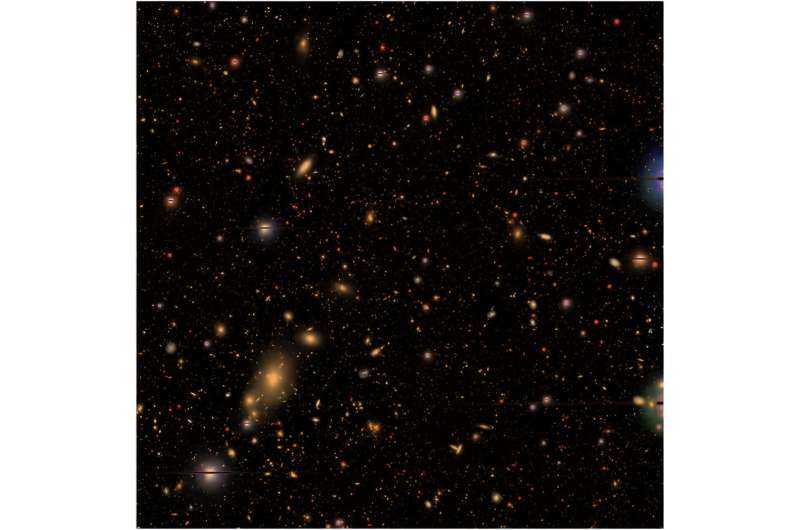Kaveri Institute of Cosmic Physics and Mathematics, University of Tokyo
Figure 1: Image obtained by observing the large-scale structure of the universe. The numerous objects shown in yellow to red represent galaxies hundreds of millions of light-years away from Earth. Galaxies come in all kinds of colors and shapes, and there are too many to count in the vastness of space. The spatial distribution and shape patterns of these galaxies are not random, but do have “correlations” derived from the statistical properties of the original fluctuations in the seeds of inflationary predictions. Image source: Subaru HSC
A recent study published in the journal Science reported that a team of researchers analyzed more than 1 million galaxies to explore the origins of today’s structure in the universe. Physical Review D As an editor’s suggestion.
To this day, precise observations and analyzes of the Cosmic Microwave Background (CMB) and Large Scale Structure (LSS) have established the standard framework of the universe, the so-called CDM model, in which cold dark matter (CDM) and dark energy (the cosmological constant) are important characteristics.
This model holds that primordial fluctuations were generated at the beginning of the universe or in the early universe, and these fluctuations acted as triggers that led to the creation of everything in the universe, including stars, galaxies, galaxy clusters, and their spatial distribution throughout space. . Although they are very small when they are created, the fluctuations grow larger over time due to gravity, eventually forming dense regions of dark matter, or halos. Then, different halos will repeatedly collide and merge with each other, resulting in the formation of celestial objects such as galaxies.
Since the properties of the spatial distribution of galaxies are strongly affected by the properties of the original fluctuations that originally produced them, statistical analyzes of galaxy distributions are actively performed to observe and explore the properties of the original fluctuations. In addition to this, the spatial pattern of galaxy shapes spread over vast areas of the universe also reflects the nature of the underlying primordial fluctuations (Fig. 1).
However, conventional analyzes of large-scale structure focus only on the spatial distribution of galaxies as points. Recently, researchers have begun studying galaxy shape because it not only provides additional information, but also provides a different perspective on the nature of the original fluctuations (Figure 2).

Figure 2: Visualization of how “different” primordial fluctuations in the universe lead to different spatial distributions of dark matter. The center plot (common to both upper and lower rows) shows fluctuations in a reference Gaussian distribution. The color gradient (blue to yellow) corresponds to the fluctuating values at that location (low to high density area). The left and right graphs show fluctuations that deviate slightly from Gaussian distribution, or are non-Gaussian. The sign in parentheses indicates the sign of the deviation from Gaussianity, corresponding to negative (-) deviations on the left and positive (+) deviations on the right. The top row is an example of isotropic non-Gaussianity. The left image shows an increase in large negative (dark blue) areas, while the right image shows an increase in large positive (bright yellow) areas compared to the central Gaussian fluctuations. It is known that we can use the observed spatial distribution of galaxies to look for this isotropic non-Gaussianity. The figure below shows an example of anisotropic non-Gaussianity. Compared to the isotropic case in the upper panel, the overall brightness and darkness of the Gaussian fluctuations in the center panel do not change, but the shape of each region does. We can look for this “anisotropic” non-Gaussian nature in the spatial patterns of galaxy shapes.Image source: Kurita Takada
By then Kavli IPMU graduate student Toshiki Kurita (currently a postdoctoral researcher at the Max Planck Institute for Astrophysics) and Kavli IPMU A research team led by Professor Masahiro Takada has developed a method for measuring the power spectrum of galaxy shapes, which extracts key statistical information from galaxy shape patterns by combining spectral data on the spatial distribution of galaxies and imaging data on individual galaxy shapes. .
The researchers also analyzed the spatial distribution and shape patterns of about 1 million galaxies in the Sloan Digital Sky Survey (SDSS), the largest galaxy survey in the world today.
As a result, they succeeded in constraining the statistical properties of the primordial fluctuations that provide the basis for the formation of the entire structure of the universe.
They found a statistically significant consistency in the orientation of the shapes of two galaxies more than 100 million light-years apart (Figure 3). Their results show that distant galaxies are related, and that their formation processes are apparently independent and causally unrelated.

Figure 3: The blue dots and error bars are the values of the galaxy shape power spectrum. The vertical axis corresponds to the correlation strength between the two galaxy shapes, i.e. the alignment of the galaxy shape directions. The horizontal axis represents the distance between two galaxies, and the left (right) axis represents the correlation between more distant (nearer) galaxies. Gray dots represent non-physical obvious correlations. As expected, the value is zero within the error margin, a fact that confirms that the blue measuring point is indeed a signal of astrophysical origin. The black curve is the theoretical curve of the most standard inflation model, which was found to match the actual data points very well.Image source: Kurita & Takada
“In this study, we were able to place constraints on the nature of the primordial fluctuations by statistically analyzing the ‘shape’ of numerous galaxies obtained from large-scale structural data. There is little precedent for using galaxy shape to explore this. The physics of the early universe and its research process, from the construction of ideas and the development of analytical methods to actual data analysis, are a series of trials and errors.
“Therefore, I faced many challenges. But I am happy to be able to complete them during my doctoral program. I believe this achievement will be the first step in opening up a new research field in cosmology using galaxy shapes,” Kurita said.
Furthermore, a detailed study of these correlations confirms that they are consistent with those of inflation forecasts and do not exhibit the non-Gaussian characteristics of the original fluctuations.
“This study is the result of Toshiki’s doctoral thesis. It is an excellent work in which we develop a method to use galaxy shape and galaxy distribution to validate a cosmological model, apply it to the data, and then test the physics of inflation study. A research topic that no one had done before, but he did all three steps: theory, measurement, and application. Congratulations! I’m very proud that we were able to complete all three steps. Unfortunately, I didn’t “Detecting the new physics of inflation is a great discovery, but we have charted a path for future research,” Detakata said. We can expect to open up more research areas with the Subaru Prime Focus spectrometer. “
The study’s methods and results will allow researchers to further test inflation theory in the future.
More information:
Toshiki Kurita et al., Constraints on anisotropic primitive non-Gaussianity by intrinsic arrangement of SDSS-III BOSS galaxies, Physical Review D (2023). DOI: 10.1103/PhysRevD.108.083533.exist arXiv: DOI: 10.48550/arXiv.2302.02925
Courtesy of Kavli Institute for Cosmic Physics and Mathematics, University of Tokyo
citation: Researchers study a million galaxies to understand how the universe began (2023, December 22), Retrieved December 22, 2023, from https://phys.org/news/2023-12-million -galaxies-universe-began.html
This document is protected by copyright. No part may be reproduced without written permission except in the interests of fair dealing for private study or research purposes. Content is for reference only.
#Researchers #study #million #galaxies #find #universe #began
Image Source : phys.org
